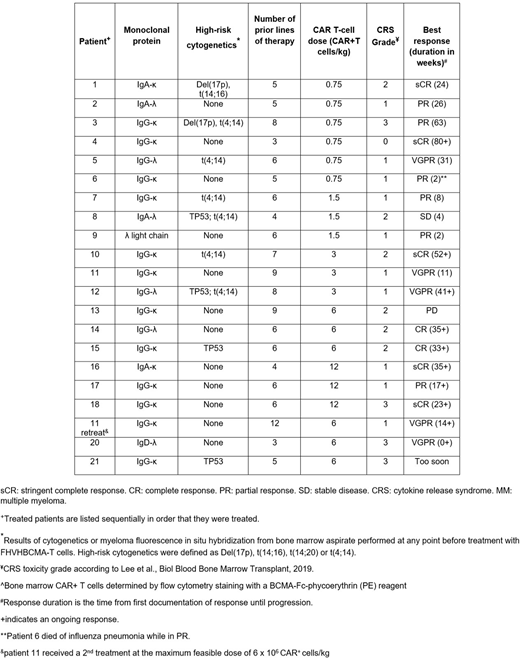T cells expressing chimeric antigen receptors (CAR) that target B-cell maturation antigen (BCMA) recognize and eliminate multiple myeloma (MM). BCMA is expressed by nearly all cases of MM. BCMA has a restricted expression pattern on normal cells. To reduce the risk of recipient immune responses against CAR T cells, we used a novel, fully-human, heavy-chain-only anti-BCMA binding domain designated FHVH33 instead of a traditional single-chain variable fragment (scFv). The FHVH33 binding domain lacks the light chain, artificial linker sequence, and 2 associated junctions of a scFv. We constructed a CAR designated FHVH33-CD8BBZ. FHVH33-CD8BBZ was encoded by a γ-retroviral vector and incorporated FHVH33, CD8α hinge and transmembrane domains, a 4-1BB costimulatory domain, and a CD3ζ domain. T cells expressing FHVH33-CD8BBZ are designated FHVH-BCMA-T.
On this clinical trial, patients received 300 mg/m2 of cyclophosphamide and 30 mg/m2 of fludarabine on days -5 to -3 followed by infusion of FHVH-BCMA-T on day 0. Twenty-one FHVH-BCMA-T infusions have been administered on 5 dose levels (DL), 0.75x106, 1.5x106, 3x106, 6x106 and 12 x106 CAR+ T cells/kg of bodyweight. DL4 (6 x 106 CAR+ T cells/kg) was identified as the maximum feasible dose (MFD) after weighing toxicity, efficacy and manufacturing factors. Patients are now being enrolled on an expansion phase to test the MFD. One patient (Patient 11) received 2 treatments. Four patients have been enrolled who were not ultimately treated. The median age of the patients enrolled is 64 (range 41-72). Patients received a median of 6 prior lines of therapy (range 3-12).
Of the 20 FHVH-BCMA-T treatments evaluable for response, 18 (90%) resulted in objective responses (OR). Twelve treatments resulted in VGPR, complete remission (CR) or stringent complete remission (sCR). Ten patients (50%) have ongoing responses that range between 0-80 weeks (6 sCR/CRs, 3 VGPRs, 1 PR). At the highest two DLs (8 patients), 7 patients (88%) have ongoing responses (median duration 20 weeks, range 0+ to 35+ weeks); progressive MM occurred in only 1 patient who had evidence of spinal cord compression on day +5 due to a rapidly expanding plasmacytoma, which required early intervention with high-dose corticosteroid and radiation therapy. Of the 8 patients evaluated for response who had high-risk cytogenetics at baseline, 7 had ORs. Responses are ongoing in 2 patients with TP53 mutations and 1 patient with t(4;14) translocation.
Ten treated patients came off study due to progressive MM (9 patients) or death from other causes (1 patient, influenza). Two of 4 patients who had plasmacytomas evaluated for BCMA expression at relapse had evidence of BCMA-negative MM. Four patients had bone marrow aspirates evaluated for BCMA-expression before treatment and at the time of relapse; 3 of these patients had evidence of loss of BCMA expression at relapse.
Of 21 FHVH-BCMA-T treatments administered, 20 (95%) were followed by cytokine release syndrome (CRS) with 16 (76%) cases of grade 1 or 2 CRS, 4 cases (19%) of grade 3 CRS, and no cases of grade 4 CRS. Three patients received tocilizumab. The median peak C-reactive protein after all 21 treatments was 196.9 mg/L. Of 21 total treatments, 8 (38%) were followed by neurologic toxicity; there were 5 cases of grade 1-2 neurologic toxicity (headache, dysarthria, confusion, delirium), 2 cases of grade 3 neurologic toxicity (confusion), and 1 patient with grade 4 spinal cord compression due to progressive MM. Two patients received corticosteroids to manage neurologic toxicities.
A median of 3.0% (range 0-95%) of bone marrow T cells were CAR+ when assessed by flow cytometry 14 days after FHVH-BCMA-T infusion. We assessed blood CAR+ cells by quantitative PCR. The median peak level of CAR+ cells was 121 cells/µl (range 3-359 cells/µl) and the median day post-infusion of peak blood CAR+ cell levels was 12 (range 7-14).
The results from this phase 1 trial demonstrate that FHVH-BCMA-T cells can induce deep and durable responses of relapsed MM with manageable toxicities. Assessment of durability of responses at the maximum feasible dose is a critical future plan. Accrual to the expansion cohort continues.
Manasanch:Novartis: Research Funding; Adaptive Biotechnologies: Honoraria; GSK: Honoraria; JW Pharma: Research Funding; Merck: Research Funding; Quest Diagnostics: Research Funding; Takeda: Honoraria; Sanofi: Honoraria; BMS: Honoraria; Sanofi: Research Funding. Rosenberg:Kite, A Gilead Company: Consultancy, Patents & Royalties, Research Funding. Kochenderfer:Kite, a Gilead company: Patents & Royalties, Research Funding; Celgene: Patents & Royalties, Research Funding; bluebird, bio: Patents & Royalties.
cyclophosphamide 300 mg/m2 fludarabine 30 mg/m2 Conditioning chemotherapy prior to CAR T-cell infusion
Author notes
Asterisk with author names denotes non-ASH members.


